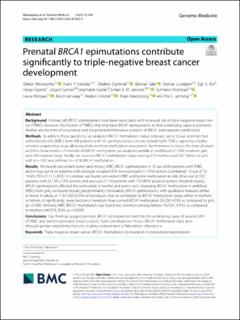| dc.contributor.author | Nikolaienko, Oleksii | |
| dc.contributor.author | Eikesdal, Hans Petter | |
| dc.contributor.author | Berge, Elisabet Ognedal | |
| dc.contributor.author | Gilje, Bjørnar | |
| dc.contributor.author | Lundgren, Steinar | |
| dc.contributor.author | Blix, Egil Støre | |
| dc.contributor.author | Espelid, Helge | |
| dc.contributor.author | Geisler, Jürgen | |
| dc.contributor.author | Geisler, Stephanie | |
| dc.contributor.author | Janssen, Emiel | |
| dc.contributor.author | Yndestad, Synnøve | |
| dc.contributor.author | Minsaas, Laura | |
| dc.contributor.author | Leirvaag, Beryl | |
| dc.contributor.author | Lillestøl, Reidun Kristine | |
| dc.contributor.author | Knappskog, Stian | |
| dc.contributor.author | Lønning, Per Eystein | |
| dc.date.accessioned | 2024-02-14T14:34:45Z | |
| dc.date.available | 2024-02-14T14:34:45Z | |
| dc.date.created | 2023-12-19T10:27:48Z | |
| dc.date.issued | 2023 | |
| dc.identifier.citation | Nikolaienko, O., Eikesdal, H.P., Ognedal, E., Gilje, B., Lundgren, S., Blix, E.S., Espelid, H., Geisler, J., Geisler, S., Janssen, E.M., Yndestad, S., Minsaas, L., Leirvaag, B., Lillestøl, R., Knappskog, S. & Lønning, P.E. (2023) Prenatal BRCA1 epimutations contribute significantly to triple-negative breast cancer development. Genome Medicine, 15 (1) | en_US |
| dc.identifier.issn | 1756-994X | |
| dc.identifier.uri | https://hdl.handle.net/11250/3117638 | |
| dc.description.abstract | Background
Normal cell BRCA1 epimutations have been associated with increased risk of triple-negative breast cancer (TNBC). However, the fraction of TNBCs that may have BRCA1 epimutations as their underlying cause is unknown. Neither are the time of occurrence and the potential inheritance patterns of BRCA1 epimutations established.
Methods
To address these questions, we analyzed BRCA1 methylation status in breast cancer tissue and matched white blood cells (WBC) from 408 patients with 411 primary breast cancers, including 66 TNBCs, applying a highly sensitive sequencing assay, allowing allele-resolved methylation assessment. Furthermore, to assess the time of origin and the characteristics of normal cell BRCA1 methylation, we analyzed umbilical cord blood of 1260 newborn girls and 200 newborn boys. Finally, we assessed BRCA1 methylation status among 575 mothers and 531 fathers of girls with (n = 102) and without (n = 473) BRCA1 methylation.
Results
We found concordant tumor and mosaic WBC BRCA1 epimutations in 10 out of 66 patients with TNBC and in four out of six patients with estrogen receptor (ER)-low expression (< 10%) tumors (combined: 14 out of 72; 19.4%; 95% CI 11.1–30.5). In contrast, we found concordant WBC and tumor methylation in only three out of 220 patients with 221 ER ≥ 10% tumors and zero out of 114 patients with 116 HER2-positive tumors. Intraindividually, BRCA1 epimutations affected the same allele in normal and tumor cells. Assessing BRCA1 methylation in umbilical WBCs from girls, we found mosaic, predominantly monoallelic BRCA1 epimutations, with qualitative features similar to those in adults, in 113/1260 (9.0%) of individuals, but no correlation to BRCA1 methylation status either in mothers or fathers. A significantly lower fraction of newborn boys carried BRCA1 methylation (9/200; 4.5%) as compared to girls (p = 0.038). Similarly, WBC BRCA1 methylation was found less common among fathers (16/531; 3.0%), as compared to mothers (46/575; 8.0%; p = 0.0003).
Conclusions
Our findings suggest prenatal BRCA1 epimutations might be the underlying cause of around 20% of TNBC and low-ER expression breast cancers. Such constitutional mosaic BRCA1 methylation likely arise through gender-related mechanisms in utero, independent of Mendelian inheritance. | en_US |
| dc.language.iso | eng | en_US |
| dc.publisher | BioMed Central | en_US |
| dc.rights | Navngivelse 4.0 Internasjonal | * |
| dc.rights.uri | http://creativecommons.org/licenses/by/4.0/deed.no | * |
| dc.subject | brystkreft | en_US |
| dc.subject | BRCA1 | en_US |
| dc.title | Prenatal BRCA1 epimutations contribute significantly to triple-negative breast cancer development | en_US |
| dc.type | Peer reviewed | en_US |
| dc.type | Journal article | en_US |
| dc.description.version | publishedVersion | en_US |
| dc.rights.holder | © 2023 The Author(s). | en_US |
| dc.subject.nsi | VDP::Medisinske Fag: 700::Klinisk medisinske fag: 750::Onkologi: 762 | en_US |
| dc.source.volume | 15 | en_US |
| dc.source.journal | Genome Medicine | en_US |
| dc.source.issue | 1 | en_US |
| dc.identifier.doi | 10.1186/s13073-023-01262-8 | |
| dc.identifier.cristin | 2215375 | |
| cristin.ispublished | true | |
| cristin.fulltext | original | |
| cristin.qualitycode | 1 | |

